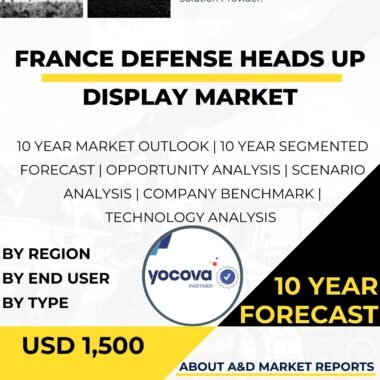Description
Brazil’s Steel Demand in the Global Aerospace and Defense Industry
Brazil Steel demand in Aerospace & Defense is strength, durability, and versatility make it a cornerstone material in the aerospace and defense sectors. It is critical for constructing aircraft, armored vehicles, naval vessels, and military infrastructure, where high-performance materials are essential for safety, reliability, and resilience.
Steel in Brazil’s Aerospace Sector
Brazil Steel demand in Aerospace & Defense Industry, high-strength steel alloys are vital for manufacturing military and civilian aircraft. These alloys are used in critical components like landing gear, engine mounts, and structural frameworks, ensuring structural integrity under extreme conditions. Brazil’s reliance on steel supports its growing aerospace sector, including contributions from companies like Embraer, and reinforces its role in the global aerospace market.
Steel in Brazil’s Defense Sector
In defense applications, steel is indispensable for producing armored vehicles, naval ships, and military infrastructure. Its resistance to ballistic threats and harsh environmental conditions enhances the durability and effectiveness of military assets. Brazil’s steel demand reflects its commitment to strengthening national security and protecting military personnel through robust defense capabilities.
Strategic Collaborations
Brazil actively collaborates with international aerospace and defense organizations, research institutions, and steel manufacturers. These partnerships drive innovation, facilitate knowledge exchange, and promote the standardization of steel alloys to meet global industry requirements. Such cooperation ensures Brazil’s steel solutions align with the evolving needs of the aerospace and defense sectors.
Investment in Research and Development (R&D)
Brazil’s success in leveraging steel is supported by significant investments in R&D, focusing on metallurgy, materials science, and advanced manufacturing. Universities and innovation centers develop high-performance steel alloys tailored to the stringent demands of aerospace and defense applications, keeping Brazil at the forefront of material advancements.
Future Outlook and Strategic Importance
As aerospace and defense technologies evolve, the demand for high-strength, durable materials like steel continues to grow. Brazil’s expertise in steel applications enhances its contributions to global markets while supporting national security objectives. Its focus on innovation and collaboration ensures that its steel solutions meet the rigorous standards of modern aerospace and defense systems.
Conclusion
Brazil’s increasing steel demand in the aerospace and defense industries underscores its dedication to technological advancement, national security, and industrial innovation. Through strategic partnerships, robust R&D, and the application of advanced steel alloys, Brazil solidifies its role as a key contributor to the global aerospace and defense sectors, driving progress in critical applications worldwide.
Table of content
Table Of Contents
1 Market Introduction
1.1 Market Introduction
1.2 Market Definition
1.3 Market Segmentation
1.4 10 Year Market Outlook
2 Market Technologies
3 Global Market Forecast
3.1 Global Market Forecast
3.2 By Component
3.3 By Process
4 South AmericaMarket Trends & Forecast
4.1 Drivers, Restraints And Challenges
4.2 PEST
4.3 Market Forecast
4.3.1 Market Forecast By Component
4.3.2 Market Forecast By Process
4.4 Scenario Analysis
4.5 Key Companies& Profiling
5 Brazil Analysis
5.1 Current Levels Of Technology Maturation In This Market
5.2 Market Forecast
5.2.1 Market Forecast By Component
5.2.2 Market Forecast By Process
5.3 Scenario Analysis
5.4 Country Defense Budget (Historical and 10- year forecast)
5.5 Defense Budget Category Spending- 10- year forecast
5.6 Procurement Analysis
5.7 EXIM Data
5.8 Patents
6 Opportunity Matrix
6.1 By Component
6.2 By Process
7 Scenario Analysis
7.1 Scenario 1
7.1.1 By Component(Scenario-1)
7.1.2 By Process(Scenario-1)
7.2 Scenario 2
7.2.1 By Component(Scenario-2)
7.2.2 By Process(Scenario-2)
8 Company Benchmark
9 Strategic Conclusions
10 About Aviation And Defense Market Reports
List of Tables
Table1: Global Market Forecast, Steel demand in Aerospace & Defense Industry
Table2: South America Market Forecast, Steel demand in Aerospace & Defense Industry
Table3: South America Market Forecast, By Component
Table4: South America Market Forecast, By Process
Table5: South America, Scenario Analysis
Table6: Brazil Market Forecast, Steel demand in Aerospace & Defense Industry
Table7: Brazil Market Forecast, By Component
Table8: Brazil Market Forecast, By Process
Table9: Brazil, Scenario Analysis
Table 10: Brazil Defense Budget 10 Year Forecast
Table 11: Brazil, Defense Budget Category Spending- 10- year forecast
Table 12: Brazil, Procurement Analysis
Table 13: Brazil, EXIM Data Analysis
Table 14: Brazil, Opportunity Analysis, By Component
Table 15: Brazil, Opportunity Analysis, By Process
Table 16: Brazil, Scenario Analysis, By Component
Table 17: Brazil, Scenario Analysis, By Process
Figure 1: Market Segmentation, Brazil Steel demand in Aerospace & Defense Industry
Figure 2: Key Technology Analysis, Steel demand in Aerospace & Defense Industry
Figure 3: Global Market Forecast, Steel demand in Aerospace & Defense Industry
Figure 4: South America, Market Forecast, Steel demand in Aerospace & Defense Industry
Figure 5: South America, Market Forecast, By Component
Figure 6: South America, Market Forecast, By Process
Figure 7: South America, Scenario Analysis
Figure 8: Brazil, Market Forecast, Steel demand in Aerospace & Defense Industry
Figure 9: Brazil, Market Forecast, By Component
Figure 10: Brazil, Market Forecast, By Process
Figure 11: Brazil, Scenario Analysis
Figure 12: Brazil, Defense Budget 10 Year Forecast
Figure 13: Brazil, Defense Budget Category Spending- 10- year forecast
Figure 14: Brazil, Procurement Analysis
Figure 15: Brazil, EXIM Data Analysis
Figure 16: Brazil, Opportunity Analysis, By Component
Figure 17: Brazil, Opportunity Analysis, By Process
Figure 18: Brazil, Scenario Analysis, By Component
Figure 19: Brazil, Scenario Analysis, By Process
Figure 20: Company Benchmark




